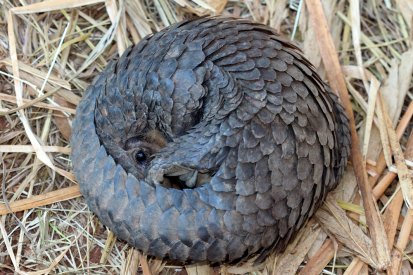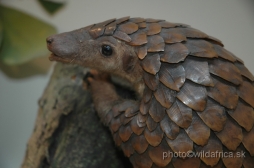
Taxonomy:
- Domain: Eukarya
- Kingdom: Animalia
- Phylum: Chordata:
- Class: Mammalia
- Order: Pholidota
- Family: Manidae
- Genus: Manis
# of Known Species: 8
Pangolins are solitary and nocturnal insectivores, easily identified by their scaly armor. The only vulnerable features of pangolins are their faces and underbellies. Though nicknamed the scaly anteater, pangolins are not related to the order Xenarthran that includes anteaters and armadillos. This mistake is due to the similar body shape, diet, and behaviors that pangolins and anteaters share. Instead, they are more closely related to the order Carnivora.
Physical Features:

The pangolin’s most notable features are its small head, long tongue, and of course, its scales.
Pangolins are the only scaly mammal species. Pangolin’s scales typically make up about 20% of its weight, covering majority of the pangolin’s body. The underbelly is covered with sparse fur. These scales are keratin, the same protein material that makes up our nails. Pangolins’ scales grow throughout a their lifetime and are constantly being filed down as pangolins dig through soil in search of food.
Another interesting feature is the pangolins’ special facial muscles. They are able to seal their nostrils and ears shut, protecting them from attacking insects. Others are located in their mouths to prevent insects from escaping.
Diet:
The pangolin’s diet mainly consists of ants and termites, although may be supplemented with other invertebrates such as flies, earthworms, and crickets. Because of their weak vision, pangolins rely on their well-developed sense of smell. Pangolins are well adapted for digging.
They dig burrows with their strong front legs and claws, using their tails and rear legs for support and balance. Their long, curved claws are used to dig from ant or termite hills as well as fallen logs to reach their prey. After using its claws to gain access to food, the pangolin uses its extremely long tongue, which can be up to 16 inches depending on the species, to eat. To make sure that the ants and termites stick, its tongue is coated with gummy mucus.
Instead of teeth, pangolins have a gizzard-like stomach that is adapted for grinding food. Gastroliths, or small stones, and sand are consumed to assist in digestion.

Behavior:

Mystery surrounds the pangolin’s behaviors and habits because of the difficulty scientists face when studying these solitary and secretive mammals in the wild. All eight species are nocturnal and emerge in the evening to begin foraging for insects.
The most well-known behavior observed in pangolins is their self-defense tactic. Like armadillos, pangolins roll themselves into a ball when they feel threatened. Hiding their vulnerable underbelly and face, their armor-plated scales protect the pangolin while inflicting wounds if anything is inserted between the scales.
Prior to contact though, pangolins will hiss and puff, lashing their tails to scare off any approaching predators. But once threatened, pangolins will roll up into a tight, impenetrable ball. Other tactics once caught include releasing stinky fluid from their glands and thrashing about using their tail muscles.
Despite their many similar characteristics and habits, there are also differences. For example, some species, such as the Chinese pangolin, are known to sleep in underground burrows while others, like the African white-bellied pangolin, sleep in trees. A physical difference between the Asian and African species is that the Asian species have bristles

that emerge between the scales.
Species:
The eight pangolin species have a wide native range of territory that spans across Africa, India, Southeast Asia, and Indonesia.
Asian Pangolin Species
- Chinese or Formosan Pangolin (Manis pentadactyla) – Critically Endangered
- Malayan or Sunda Pangolin (Manis javanica) – Critically Endangered
- Indian Pangolin (Manis crassicaudata) – Endangered
- Palawan or Philippine Pangolin (Manis Culionensis) – Endangered
African Pangolin Species
- Tree or African White-bellied Pangolin (Manis phataginus tricuspis) – Vulnerable
- Giant Ground Pangolin (Manis Gigantea) – Vulnerable
- Cape or Temminck’s Ground Pangolin (Manis temminckii) – Vulnerable
- Long-tailed or Black-Bellied Pangolin (Manis uromanis tetradactyla) – Vulnerable

Species vary in size, as seen in the picture above, ranging from 1.6 kg (~1.5 lbs) to 33 kg (~73 lbs).
Conservation:
Pangolins are the most illegally traded mammals in the world. All eight species are protected under national and international laws but have been overlooked for other wildlife trade targets. Their statuses are listed from vulnerable to critically endangered, the Chinese and Malayan pangolin, on the IUCN Red List of Threatened Species.
Pangolins are extremely profitable. Their meat and scales are valuable as luxury delicacy and for traditional Chinese medicine. Once a supplemental protein source in rural villages, the pangolin is now considered a luxury for the wealthy and middle class. One million pangolins in the past 10 years were poached from the wild. Populations are estimated to have declined by up to 80% percent.
This large-scale illegal trade have drastically driven the Asian pangolins’ numbers throughout Southeast Asia. Dwindling numbers have caused traders and poachers to look to Africa to meet the growing demand. Other causes include the rapid loss of habitat that can support the pangolins.
Pangolins give birth to a single young, once a year, making it difficult for an increase in population. With increasing pressure and exploitation, all pangolin species are being driven to extinction.
These creatures remain largely unknown. Easily overshadowed by other popular black-marketed animals like the tiger, elephant, and rhino, international environmental groups and governments are slow to fund pangolin research and rescue.

Interesting Facts:
- Pangolin’s tongues can be longer than their bodies. It is so long that it starts deep in the chest cavity.
- The African White-bellied pangolin is bipedal, meaning it can walk on its hind legs and use its tail for balance
- Baby pangolins ride around on their mothers’ back by hanging on their scales
- A single adult pangolin consumes about an average of 70 million ants/termites per year
- Due to the lack of research, no one knows the lifespan of these species. However, in captivity, the longest-living pangolin was 20 years old.
- Their name is derived from the Malay word “pengguling”, which loosely translates to “something that rolls up”
- Some species, like the Long-tailed pangolin, have prehensile tails that help in climbing or hanging from trees and branches.
~~~~~~~~~~~~~~~~~~~~~~~~~~~~~~~~~~~~~~~~~~~~~~~~~~~~~~~~~~~~~~~~~~~~~~~~~
It was recently (2/20/16) World Pangolin Day and thought that the pangolin would be an awesome way to start off this blog!
Thank you for reading and leave your comments below! Subscribe to get notified for new posts. Check the ‘About’ Page to learn more about me and find information about the schedule.
~~~~~~~~~~~~~~~~~~~~~~~~~~~~~~~~~~~~~~~~~~~~~~~~~~~~~~~~~~~~~~~~~~~~~~~~~

References + For More Reading
African Wildlife Foundation – Pangolin
Where Have All the Pangolins Gone?
The Most Trafficked Mammal You’ve Never Heard Of
IUCN Redlist – Saving the World’s most illegally traded wild mammal



Pingback: Animal Spotlight: Pink Fairy Armadillo – Animal Almanac
Wow, this article is good, my younger sister is analyzing these things,
so I am going to let know her.
LikeLike
Hi would you mind stating which blog platform you’re using?
I’m looking to start my own blog soon but I’m having
a difficult time choosing between BlogEngine/Wordpress/B2evolution and Drupal.
The reason I ask is because your layout seems
different then most blogs and I’m looking for something completely
unique. P.S Apologies for getting off-topic but I had
to ask!
LikeLike
Sorry for the late reply Kristin but I use wordpress to run my blog. Hope this helps and good luck on your blog!
LikeLike
I love it when folks come together and share ideas.
Great website, stick with it!
LikeLike
I have been surfing online more than three hours today, but
I by no means found any attention-grabbing article like
yours. It is beautiful price sufficient for me.
In my opinion, if all site owners and bloggers made excellent content as you probably did,
the net will likely be much more helpful than ever before.
LikeLike
Greetings from Florida! I’m bored to tears at work so I decided
to browse your blog on my iphone during lunch break.
I love the information you provide here and can’t wait to take a look when I get home.
I’m shocked at how quick your blog loaded on my cell phone ..
I’m not even using WIFI, just 3G .. Anyways, fantastic site!
LikeLike
Hola! I’ve been reading your web site for a long time now and finally got the courage to go ahead and give you a shout out from Porter Texas! Just wanted to tell you keep up the good work!
LikeLike
I like what you guys are up too. Such clever work and reporting!
Carry on the excellent works guys I’ve incorporated you guys to my blogroll.
I think it will improve the value of my website :
).
LikeLike
why
LikeLike
Appreciating the commitment you put into your blog and in depth information you present.
It’s nice to come across a blog every once in a while that isn’t the same old rehashed information. Wonderful
read! I’ve saved your site and I’m including your
RSS feeds to my Google account.
LikeLike
I’m impressed, I have to admit. Seldom do I
encounter a blog that’s equally educative and engaging, and
without a doubt, you have hit the nail on the head. The problem is something too few men and women are speaking intelligently about.
I’m very happy that I came across this during my hunt for something
relating to this.
LikeLike
It’s awesome to go to see this website and reading the views of all friends on the topic of this piece of
writing, while I am also eager of getting knowledge.
LikeLike
Hi! This post could not be written any better! Reading this post reminds me of my
good old room mate! He always kept talking about this.
I will forward this page to him. Fairly certain he will have a good read.
Thank you for sharing!
LikeLike
Very nice post. I absolutely appreciate this site. Stick with it!
LikeLike
You’re so awesome! I do not suppose I have read through anything like that before.
So nice to discover another person with genuine thoughts
on this subject. Seriously.. thanks for starting this up.
This site is one thing that’s needed on the web, someone with some originality!
LikeLike
This is my first time pay a quick visit at here and i am truly pleassant to read everthing at single place.
LikeLike
I have to thank you for the efforts you’ve put in penning this site.
I really hope to view the same high-grade blog posts from
you later on as well. In truth, your creative writing
abilities has inspired me to get my own website now 😉
LikeLike
An impressive share! I have just forwarded this onto a coworker who had been conducting a little homework on this.
And he in fact ordered me lunch simply because I discovered it
for him… lol. So allow me to reword this…. Thank YOU
for the meal!! But yeah, thanx for spending some time to discuss this topic here on your web page.
LikeLike
Greetings from Idaho! I’m bored at work so I decided to check out your blog on my iphone during lunch break.
I love the info you present here and can’t wait to take a look when I get home.
I’m amazed at how quick your blog loaded on my mobile ..
I’m not even using WIFI, just 3G .. Anyways, wonderful site!
LikeLike
Have you ever thought about publishing an e-book or guest
authoring on other websites? I have a blog centered on the
same topics you discuss and would love to have you share some stories/information.
I know my viewers would appreciate your work.
If you are even remotely interested, feel free to shoot me an e mail.
LikeLike